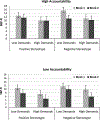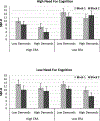Motivation moderates the impact of aging stereotypes on effort expenditure
- PMID: 30211597
- PMCID: PMC6367024
- DOI: 10.1037/pag0000291
Motivation moderates the impact of aging stereotypes on effort expenditure
Abstract
The impact of aging stereotypes on task engagement was examined. Older adults (N = 144, ages 65 to 85) were exposed to primes designed to activate positive or negative stereotypes about aging, with half of the individuals in each stereotype group also assigned to a high-accountability condition to enhance motivation. Participants performed a memory-scan task comprising 2 levels of demands (memory sets of 4 or 7 items), with 2 blocks (5 min each) at each level. Systolic blood pressure recorded throughout the task was used to monitor engagement levels. High accountability was associated with greater engagement at the highest level of task demands. Negative stereotype activation also resulted in elevated engagement levels, but only during the initial trial blocks in the high-accountability condition. Lowest levels of engagement were associated with low accountability, with no difference between stereotype conditions. An analogous differential analysis on these same data using need for cognition and attitudes toward aging as measures of motivation and stereotypes revealed similar trends. Specifically, negative aging attitudes were associated with elevated levels of engagement only in individuals who were high in intrinsic motivation, with the effects greatest at the highest levels of task demands. The results provide a more nuanced perspective on the impact of negative aging stereotypes than suggested in previous research, with the impact on behavior moderated by situational and personal factors associated with motivation. Although potentially negative in the long run, elevated cardiovascular responses indicative of task engagement may represent an adaptive response to support performance. (PsycINFO Database Record (c) 2019 APA, all rights reserved).
Figures



References
-
- Barber SJ, Mather M, & Gatz M (2015). How stereotype threat affects healthy older adults’ performance on clinical assessments of cognitive decline: The key role of regulatory fit. The Journals of Gerontology: Series B: Psychological Sciences and Social Sciences, 70, 891–900. 10.1093/geronb/gbv009 - DOI - PMC - PubMed
-
- Berntson GG, Quigley KS, & Lozano D (2007). Cardiovascular psychophysiology In Cacioppo JT, Tassinary LG, Berntson GG, Cacioppo JT, Tassinary LG, Berntson GG (Eds.) , Handbook of psychophysiology, 3rd ed (pp. 182–210). New York, NY, US: Cambridge University Press. doi: 10.1017/CBO9780511546396.008 - DOI
MeSH terms
Grants and funding
LinkOut - more resources
Full Text Sources
Other Literature Sources
Medical

